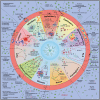The microbiota-microglia axis in central nervous system disorders
- PMID: 33073887
- PMCID: PMC8018151
- DOI: 10.1111/bpa.12908
The microbiota-microglia axis in central nervous system disorders
Abstract
The innate immune system in the central nervous system (CNS) is mainly represented by specialized tissue-resident macrophages, called microglia. In the past years, various species-, host- and tissue-specific as well as environmental factors were recognized that essentially affect microglial properties and functions in the healthy and diseased brain. Host microbiota are mostly residing in the gut and contribute to microglial activation states, for example, via short-chain fatty acids (SCFAs) or aryl hydrocarbon receptor (AhR) ligands. Thereby, the gut microorganisms are deemed to influence numerous CNS diseases mediated by microglia. In this review, we summarize recent findings of the interaction between the host microbiota and the CNS in health and disease, where we specifically highlight the resident gut microbiota as a crucial environmental factor for microglial function as what we coin "the microbiota-microglia axis."
Keywords: CNS diseases; bacteria; fecal microbiota transplantation; germ-free; gut-brain axis; microbiota; microbiota-microglia axis; microglia; short-chain fatty acids.
© 2020 International Society of Neuropathology.
Figures

Similar articles
-
The Gut-Microglia Connection: Implications for Central Nervous System Diseases.Front Immunol. 2018 Oct 5;9:2325. doi: 10.3389/fimmu.2018.02325. eCollection 2018. Front Immunol. 2018. PMID: 30344525 Free PMC article. Review.
-
How microbiota shape microglial phenotypes and epigenetics.Glia. 2020 Aug;68(8):1655-1672. doi: 10.1002/glia.23822. Epub 2020 Mar 17. Glia. 2020. PMID: 32181523
-
Berberine alleviates visceral hypersensitivity in rats by altering gut microbiome and suppressing spinal microglial activation.Acta Pharmacol Sin. 2021 Nov;42(11):1821-1833. doi: 10.1038/s41401-020-00601-4. Epub 2021 Feb 8. Acta Pharmacol Sin. 2021. PMID: 33558654 Free PMC article.
-
Elucidating the specific mechanisms of the gut-brain axis: the short-chain fatty acids-microglia pathway.J Neuroinflammation. 2025 May 21;22(1):133. doi: 10.1186/s12974-025-03454-y. J Neuroinflammation. 2025. PMID: 40400035 Free PMC article. Review.
-
Butyrate ameliorates chronic alcoholic central nervous damage by suppressing microglia-mediated neuroinflammation and modulating the microbiome-gut-brain axis.Biomed Pharmacother. 2023 Apr;160:114308. doi: 10.1016/j.biopha.2023.114308. Epub 2023 Jan 28. Biomed Pharmacother. 2023. PMID: 36709599
Cited by
-
Inflammation, Lifestyle Factors, and the Microbiome-Gut-Brain Axis: Relevance to Depression and Antidepressant Action.Clin Pharmacol Ther. 2023 Feb;113(2):246-259. doi: 10.1002/cpt.2581. Epub 2022 Apr 5. Clin Pharmacol Ther. 2023. PMID: 35278334 Free PMC article. Review.
-
NLRP3 inflammasome and gut microbiota-brain axis: A new perspective on white matter injury after intracerebral hemorrhage.Neural Regen Res. 2026 Jan 1;21(1):62-80. doi: 10.4103/NRR.NRR-D-24-00917. Epub 2025 Jan 29. Neural Regen Res. 2026. PMID: 39885662 Free PMC article.
-
The Microbiota-Gut-Brain Axis and Neurological Disorders: A Comprehensive Review.Life (Basel). 2024 Sep 26;14(10):1234. doi: 10.3390/life14101234. Life (Basel). 2024. PMID: 39459534 Free PMC article. Review.
-
Realgar Alleviated Neuroinflammation Induced by High Protein and High Calorie Diet in Rats via the Microbiota-Gut-Brain Axis.Nutrients. 2022 Sep 23;14(19):3958. doi: 10.3390/nu14193958. Nutrients. 2022. PMID: 36235611 Free PMC article.
-
Mechanisms of myeloid cell entry to the healthy and diseased central nervous system.Nat Immunol. 2023 Mar;24(3):393-407. doi: 10.1038/s41590-022-01415-8. Epub 2023 Feb 9. Nat Immunol. 2023. PMID: 36759712 Review.
References
-
- Metchnikoff E, Mitchell PC (1910) The Prolongation of Life, p, xxviii, 1 l. New York & London: G. P. Putnam's Sons.
-
- Cummings JH, Macfarlane GT (1997) Colonic microflora: nutrition and health. Nutrition 13:476–478. - PubMed
Publication types
MeSH terms
Grants and funding
LinkOut - more resources
Full Text Sources
Miscellaneous

